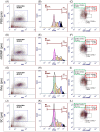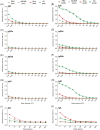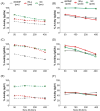Effects of prime-boost strategies on the protective efficacy and immunogenicity of a PLGA (85:15)-encapsulated Chlamydia recombinant MOMP nanovaccine
- PMID: 38862192
- PMCID: PMC11186516
- DOI: 10.1093/femspd/ftae004
Effects of prime-boost strategies on the protective efficacy and immunogenicity of a PLGA (85:15)-encapsulated Chlamydia recombinant MOMP nanovaccine
Abstract
To begin to optimize the immunization routes for our reported PLGA-rMOMP nanovaccine [PLGA-encapsulated Chlamydia muridarum (Cm) recombinant major outer membrane protein (rMOMP)], we compared two prime-boost immunization strategies [subcutaneous (SC) and intramuscular (IM-p) prime routes followed by two SC-boosts)] to evaluate the nanovaccine-induced protective efficacy and immunogenicity in female BALB/c mice. Our results showed that mice immunized via the SC and IM-p routes were protected against a Cm genital challenge by a reduction in bacterial burden and with fewer bacteria in the SC mice. Protection of mice correlated with rMOMP-specific Th1 (IL-2 and IFN-γ) and not Th2 (IL-4, IL-9, and IL-13) cytokines, and CD4+ memory (CD44highCD62Lhigh) T-cells, especially in the SC mice. We also observed higher levels of IL-1α, IL-6, IL-17, CCL-2, and G-CSF in SC-immunized mice. Notably, an increase of cytokines/chemokines was seen after the challenge in the SC, IM-p, and control mice (rMOMP and PBS), suggesting a Cm stimulation. In parallel, rMOMP-specific Th1 (IgG2a and IgG2b) and Th2 (IgG1) serum, mucosal, serum avidity, and neutralizing antibodies were more elevated in SC than in IM-p mice. Overall, the homologous SC prime-boost immunization of mice induced enhanced cellular and antibody responses with better protection against a genital challenge compared to the heterologous IM-p.
Keywords: Chlamydia; l-lactic-co-glycolide)] nanoparticles; IFN-γ; PLGA [poly (d; immunization routes.
© The Author(s) 2024. Published by Oxford University Press on behalf of FEMS.
Conflict of interest statement
The authors declare no conflict of interest.
Figures











Similar articles
-
Encapsulation of Recombinant MOMP in Extended-Releasing PLGA 85:15 Nanoparticles Confer Protective Immunity Against a Chlamydia muridarum Genital Challenge and Re-Challenge.Front Immunol. 2021 Apr 14;12:660932. doi: 10.3389/fimmu.2021.660932. eCollection 2021. Front Immunol. 2021. PMID: 33936096 Free PMC article.
-
Chlamydia trachomatis recombinant MOMP encapsulated in PLGA nanoparticles triggers primarily T helper 1 cellular and antibody immune responses in mice: a desirable candidate nanovaccine.Int J Nanomedicine. 2013;8:2085-99. doi: 10.2147/IJN.S44155. Epub 2013 May 30. Int J Nanomedicine. 2013. PMID: 23785233 Free PMC article.
-
The Chlamydia M278 Major Outer Membrane Peptide Encapsulated in the Poly(lactic acid)-Poly(ethylene glycol) Nanoparticulate Self-Adjuvanting Delivery System Protects Mice Against a Chlamydia muridarum Genital Tract Challenge by Stimulating Robust Systemic and Local Mucosal Immune Responses.Front Immunol. 2018 Oct 15;9:2369. doi: 10.3389/fimmu.2018.02369. eCollection 2018. Front Immunol. 2018. PMID: 30374357 Free PMC article.
-
The cationic liposomal adjuvants CAF01 and CAF09 formulated with the major outer membrane protein elicit robust protection in mice against a Chlamydia muridarum respiratory challenge.Vaccine. 2017 Mar 23;35(13):1705-1711. doi: 10.1016/j.vaccine.2017.02.020. Epub 2017 Feb 24. Vaccine. 2017. PMID: 28238632
-
A nanovaccine formulation of Chlamydia recombinant MOMP encapsulated in PLGA 85:15 nanoparticles augments CD4+ effector (CD44high CD62Llow) and memory (CD44high CD62Lhigh) T-cells in immunized mice.Nanomedicine. 2020 Oct;29:102257. doi: 10.1016/j.nano.2020.102257. Epub 2020 Jun 28. Nanomedicine. 2020. PMID: 32610072 Free PMC article.
Cited by
-
Progress towards effective vaccines for Chlamydia trachomatis.Curr Opin Infect Dis. 2025 Feb 1;38(1):54-59. doi: 10.1097/QCO.0000000000001075. Epub 2024 Nov 20. Curr Opin Infect Dis. 2025. PMID: 39745334 Review.
-
Nano-Oncologic Vaccine for Boosting Cancer Immunotherapy: The Horizons in Cancer Treatment.Nanomaterials (Basel). 2025 Jan 16;15(2):122. doi: 10.3390/nano15020122. Nanomaterials (Basel). 2025. PMID: 39852737 Free PMC article. Review.
References
MeSH terms
Substances
Grants and funding
LinkOut - more resources
Full Text Sources
Medical
Research Materials

